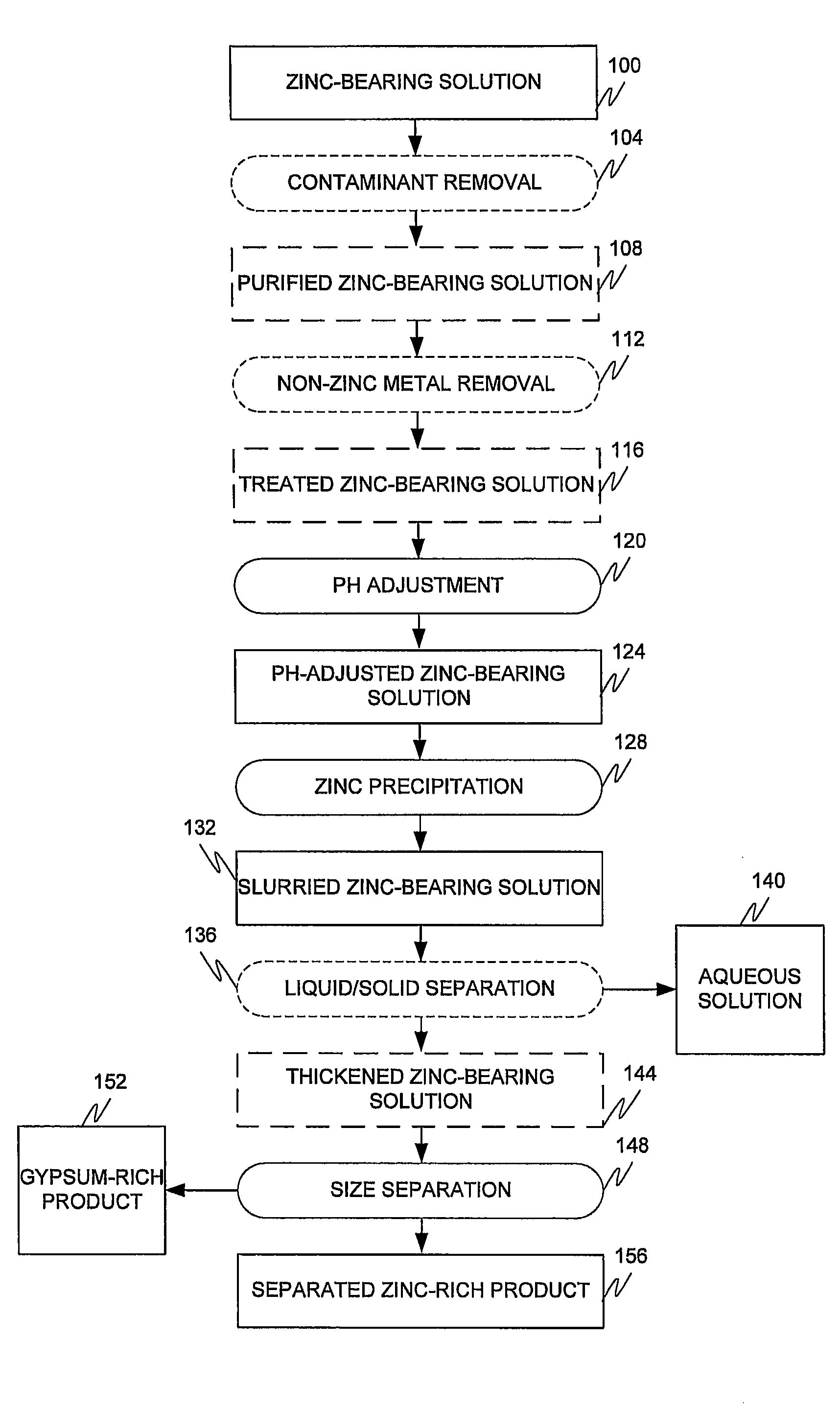Production of zinc sulphate concentrates from a dilute zinc sulphate solution
a technology of zinc sulphate and concentrate, which is applied in the field of recovery of zinc, can solve the problems of not being a suitable process for installation, not providing a versatile and cost-effective process for zinc recovery, and requiring considerable capital investment, so as to achieve high-efficiency and selective separation of zinc, the economic process of zinc recovery, and the effect of avoiding energy, capital investment and operating costs
- Summary
- Abstract
- Description
- Claims
- Application Information
AI Technical Summary
Benefits of technology
Problems solved by technology
Method used
Image
Examples
example 1
Production of Zinc Sulfate at 65° C.
[0040]A slightly acidic dilute solution of zinc sulphate was continuously fed into a series of four agitated precipitation reactors which cascaded from reactor #1 to reactor #4. The key elements in the zinc sulphate solution employed are shown in Table 1.
[0041]
TABLE 1Feed Solution analysisElementConcentrationZinc1380 ppm Magnesium50 ppmManganese18 ppmpH4-5
[0042]The temperature in the reactors was maintained between 60° C. and 70° C. with a target of 65° C. The pH in the four precipitation reactors was controlled between pH 5.5 and pH 7.5 with a target of pH 6.5 by the addition of lime. The flow rate of the feed solution was kept constant at 2.5 liters per minute so that the total retention time in the four precipitation reactors was 60 minutes, to precipitate basic zinc sulfate. The lime consumption was between 2.0 and 2.5 Kg / tonne of solid feed. No gypsum seed crystals were fed to the precipitation reactors.
[0043]After achieving steady state, the...
example 2
Production of Zinc Sulfate at 55° C.\
[0050]The same sample solution employed in Example 1 was processed in the same manner as example 1 except that the temperature was lowered to 55° C.
[0051]The wet screening results gave a slightly lower zinc recovery, 87% and a lower grade, 45% zinc.
[0052]The bulk precipitate contained 31.78% zinc and 9.59% calcium. The results in Table 4 show that when the product was screened at −25 mesh that 98.6% of the zinc product was recovered at a grade of 42.18%, which is significantly lower than the grade of 50% reported in example 1. The results indicate that even though zinc recovery may be slightly higher at lower temperatures, the grade of the final product is lower. This is due to the higher recovery of calcium in the fine product (39.3% at 55° C. and 21.4% at 65° C.). The same trend with decreased temperature is observed when the cyclone results at 65° C. and 55° C. are compared; zinc grade drops slightly from 47.2 to 45% while the zinc recovery in...
example 3
Production of Zinc Oxide at 65° C.
[0054]The same solution employed in example 1 was processed in the same manner as Example 1 except lime was added to maintain a pH of pH 10. The zinc precipitation product is therefore zinc oxide rather than basic zinc sulphate, as produced in Examples 1 and 2.
[0055]The grade of the solids precipitated was approximately 27.28% zinc and 14.88% calcium, and was lower than that observed in Examples 1 and 2. After wet screening, the −25 mesh fraction exhibited a lower zinc grade of 44% than observed in Example 1 (50%) and zinc recovery increased to 99%, as shown in Table 5.
[0056]
TABLE 5Grade and recovery of wet screened zinc products from reactor operated at 65° C., pH 10 without seedingSize Mass Grade %% Recovery(micron)Fraction %ZnZnCaMgMn+536.731.150.213.90.40.2−53-+387.542.850.615.20.60.6−38-+252.884.110.35.70.40.3−2582.8543.9498.965.298.698.8Total100100100100100
[0057]Compared to the molar ratios for the −25 mesh zinc product produced in Example 1, ...
PUM
| Property | Measurement | Unit |
|---|---|---|
| particle size | aaaaa | aaaaa |
| temperature | aaaaa | aaaaa |
| temperature | aaaaa | aaaaa |
Abstract
Description
Claims
Application Information
 Login to View More
Login to View More - R&D
- Intellectual Property
- Life Sciences
- Materials
- Tech Scout
- Unparalleled Data Quality
- Higher Quality Content
- 60% Fewer Hallucinations
Browse by: Latest US Patents, China's latest patents, Technical Efficacy Thesaurus, Application Domain, Technology Topic, Popular Technical Reports.
© 2025 PatSnap. All rights reserved.Legal|Privacy policy|Modern Slavery Act Transparency Statement|Sitemap|About US| Contact US: help@patsnap.com


